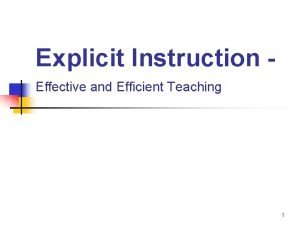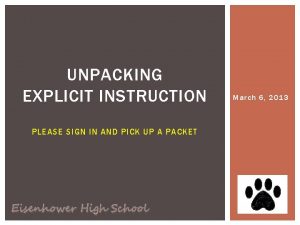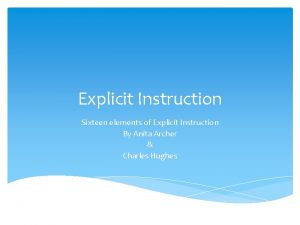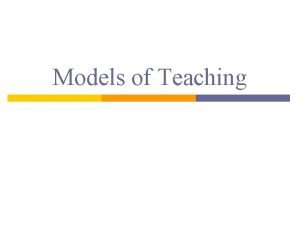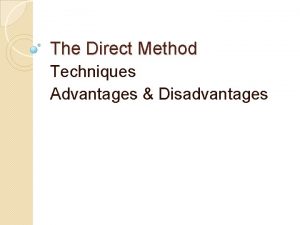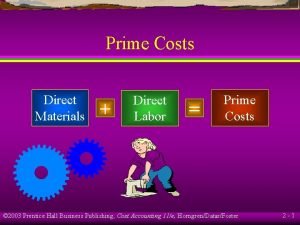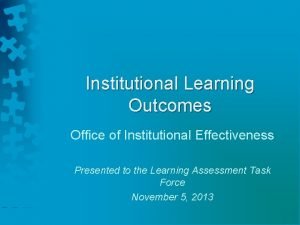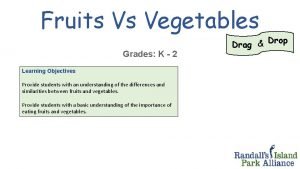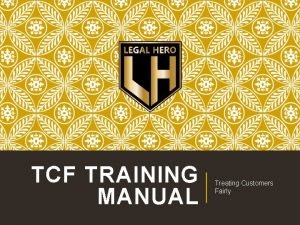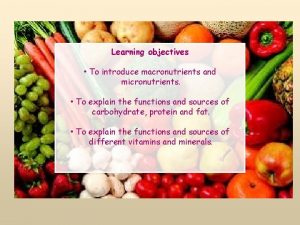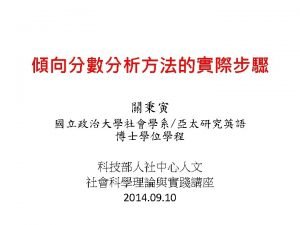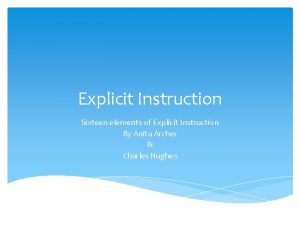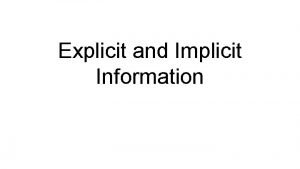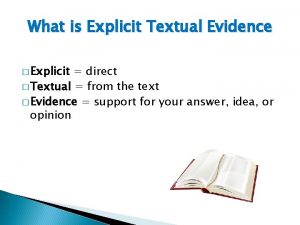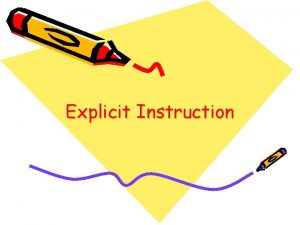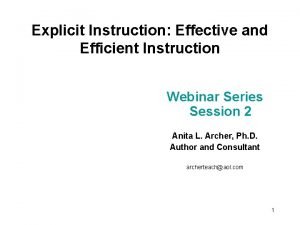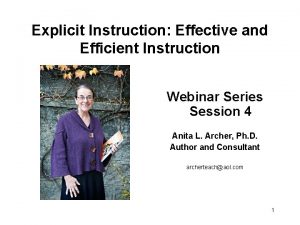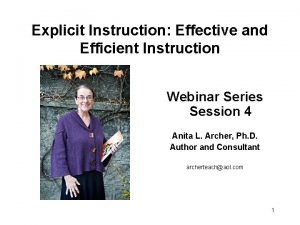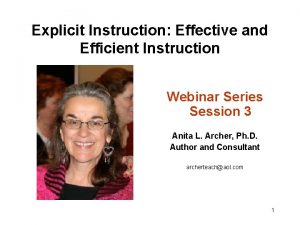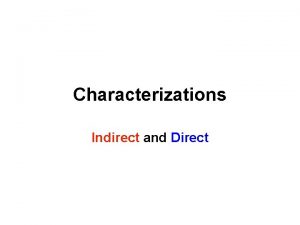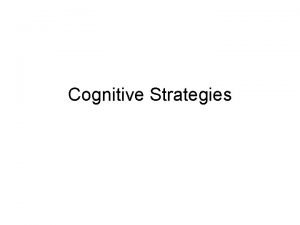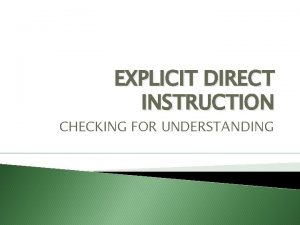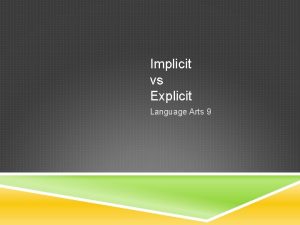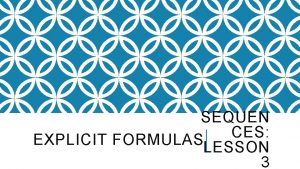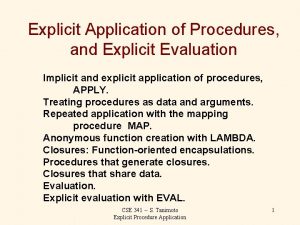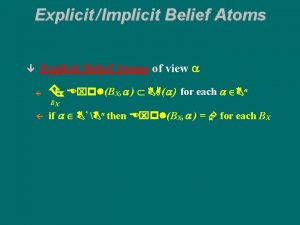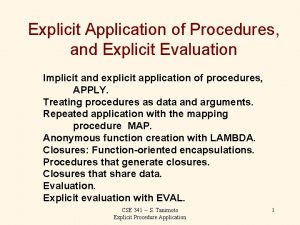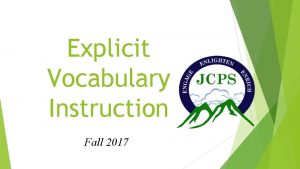WHAT IS EFFECTIVE INSTRUCTION Explicit Direct Instruction Outcomes



















- Slides: 19

WHAT IS EFFECTIVE INSTRUCTION? Explicit Direct Instruction

Outcomes Ø All teachers will know and understand our district beliefs regarding curriculum and instruction Ø All teachers will understand the EDI methods for achieving effective instruction Ø All teachers will review the tools needed for effective curriculum and instruction. Ø All teachers will understand the elements of a well structure lesson

Our Beliefs We believe students can learn with sufficient time and support. Ø We believe decisions should focus on what is best for students. Ø We believe students should be proficient in the CA Standards. Ø We believe excellent instruction maximizes academic achievement Ø We believe all schools should provide a safe and supportive learning environment Ø We believe all students have fair and equitable access to all curriculum areas Ø

All Students Successfully Taught Grade Level Work Every Day Why is teaching on grade level so very important for students? 1. Provides equal opportunity for all students. 2. Students cannot learn what they are not taught. 3. Students perform no higher than the assignments given. 4. Students test higher, even if their grades go down. 5. State tests assess grade-level content. Grade Levels The goal of instruction is high student success on grade-level content.

It’s All About YOU? ? Ø “The Teacher Effect makes all other differences pale in comparison” Sanders Ø “Five years of effective teaching can completely close the gap…” Marzano You are making a Difference The Teacher Making a Difference involves accepting major responsibilities

Instructional Effective when Students Learn. Efficient when Students Learn Quickly. Considerations In Lesson Planning Ø Lesson clear & concise Ø Lesson planning process is clear & well defined Ø Lesson planning is independent of grade level or content Ø Instruction produces high levels of successful students.

Metacognition An awareness of the process of learning. A Critical Ingredient to successful learning

Meta-cognitive Teaching Thinking about your Teaching Ø Taking conscious control of the learning Ø Planning and selecting strategies Ø Monitoring the progress of learning Ø Correcting errors Ø Analyzing the effectiveness of the learning strategies Ø Changing learning behaviors and strategies during the lessons.

Metacognition Involves Asking the Question Ø What is the specific skill and concepts I am teaching? Ø What is each effective instructional strategy? l l Ø • • Why you use it How you use it When to use it Expected results Have the results been achieved? Identify students not achieving success Additional instructional planning

Overall Curriculum Design State Essential Content Standard Assessment based on how tested (Release Questions) Pacing Calendar Unpacking the standards Learning Objective Lesson Design Instruction Lesson Delivery Assessment of Each Learning Objective Evaluate Results M E T A C O G N I T I O N


State Standards Ø Ø Ø Standards are Designed to Advance Student Knowledge Every Year l Not to Re-teach Prior Content Students must not do the same assignments year after year. Students must be taught new skills and/or concepts every year or their learning will stagnate. When curriculum lacks rigor, students get rigor mortis because they are not being taught anything new. Federal law requires states to test students each year on grade-level state standards.

Unpacking the California Standards Ø CONTENT STANDARDS l Ø SKILL is the action verb (Bloom’s Taxonomy) l l Ø Describes what the students will do Must be measurable CONCEPT is (usually) the noun (the main idea) l l Ø Contains one or more SKILLs & CONCEPTs & (sometimes) a CONTEXT Describes the main idea that the students will learn. Example; Students will write a Summary of a news article (4 th grade Writing Applications 2. 4). • Summary is the concept CONTEXT is the area that the skill and concept are being applied to. l In this case “news articles”

What is Included in a well structured lesson?

Well Structured Lesson Delivery & Design Ø Ø Ø Design specific Learning Objectives Develop Formative Assessments aligned to the Learning Objective Review Prerequisite Learning Short Statement of GOALS New materials presented in small steps with student practice after each step Give clear and detailed instructions and explanations. Provide high levels of active practice for all. Ask a large number of questions Guide students during initial practice Provide systematic feedback and corrections Provide explicit instruction and practice for seatwork exercise and monitor during seatwork.

Two Parts of Instruction Lesson Design Lesson Delivery

Explicit Direct Instruction Teacher Centered Direct Instruction Lesson Design Ø Ø Ø Ø Ø Specific Learning Objectives Formative Assessment aligned to the Learning Objective Lesson Importance Activate Prior Knowledge Concept Development Skill Development Lesson Importance Guided Practice Lesson Closure Independent Practice

Elements of Explicit Direct Instruction Lesson Delivery Introduce & teach Lesson Objective Checking for Understanding (verify student learning using TAPPLE) Ø Active Participation (students respond to sub-skill questions) Ø Differentiating Strategies (adjust sub-skills and time) Ø Cognitive Strategies (help students remember and retrieve) REO Ø Ø • Rehearsal - use exact words • Elaboration – use with different words • Organization – show relationships Ø Teaching Strategies § Explain – tell in 2 nd person § Demonstrate – use a physical object or representation § Model – think aloud in 1 st person Ø Student Support § Identify students who are not ready for independent practice

NEXT STEP Lesson Objectives
 Examples of explicit instruction
Examples of explicit instruction Direct instruction vs indirect instruction
Direct instruction vs indirect instruction Components of explicit instruction
Components of explicit instruction 16 elements of explicit instruction
16 elements of explicit instruction Explicit phonics instruction
Explicit phonics instruction Learning outcomes for direct and indirect speech
Learning outcomes for direct and indirect speech Individualized instruction vs differentiated instruction
Individualized instruction vs differentiated instruction Disadvantages of inductive method of teaching mathematics
Disadvantages of inductive method of teaching mathematics Models of teaching
Models of teaching Advantages and disadvantages of direct method pdf
Advantages and disadvantages of direct method pdf Direct material + direct labour
Direct material + direct labour Institutional learning outcomes examples
Institutional learning outcomes examples Learning objectives of fruits and vegetables
Learning objectives of fruits and vegetables Dejobbing
Dejobbing Tcf outcomes 1 6
Tcf outcomes 1 6 Junior cycle learning outcomes
Junior cycle learning outcomes Mri ib psychology
Mri ib psychology Learning about macronutrients
Learning about macronutrients Learning outcomes examples
Learning outcomes examples Group d outcomes
Group d outcomes
